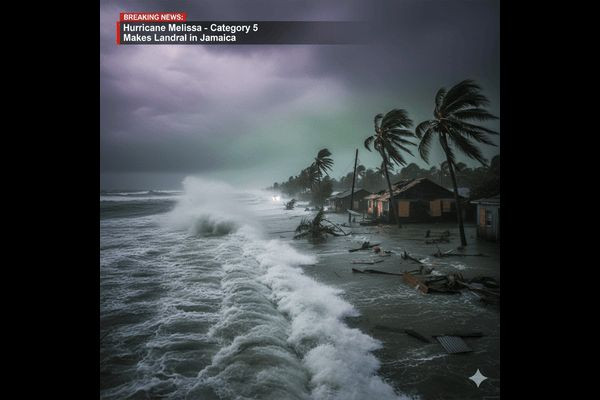A Nation Holds Its Breath: Jamaica Braces for Record-Breaking Hurricane Melissa
Kingston, Jamaica – October 28, 2025
As the early hours of Tuesday dawn across Jamaica, the nation is in a state of high-alert paralysis, bracing for a direct and potentially catastrophic strike from Hurricane Melissa, which has rapidly intensified into an exceptionally powerful Category 5 storm. Forecasters and government officials are united in their grim assessment: Melissa is on track to be the strongest hurricane to ever make a direct hit on the island since record-keeping began in 1851, threatening to unleash a disaster of unprecedented scale.
The storm’s core is projected to move near or directly over Jamaica late Monday night into Tuesday, maintaining its terrifying Category 5 intensity, characterized by sustained winds of up to 165 miles per hour (265 km/h). However, what has compounded the sense of dread is Melissa's abnormally slow traversal. Crawling at speeds as low as 3 to 5 miles per hour, the storm is forecast to linger over the island, subjecting communities to hours of relentless, destructive winds and biblical amounts of rainfall.
Mandatory Evacuations and a Race for Safety
The gravity of the threat prompted the Jamaican government to escalate its preparedness to the highest level. Prime Minister Andrew Holness issued a mandatory evacuation order for several highly vulnerable, low-lying communities along the country's south coast, including Port Royal in Kingston, and areas like Old Harbour Bay in St. Catherine and Portland Cottage in Clarendon.
The Minister of Local Government and Community Development, Desmond McKenzie, did not mince words during a press conference in Kingston, stating, "Many of these communities will not survive the flooding. Kingston is extremely low. No community in Kingston is immune.” This warning underscores the extreme threat posed by both flooding and the expected storm surge of 9 to 13 feet above normal tide levels, which could completely inundate coastal infrastructure and communities.
In response, the Office of Disaster Preparedness and Emergency Management (ODPEM) activated 881 emergency shelters across the island. The Jamaica Defence Force (JDF) has called out its reserves and deployed teams to assist with mandatory evacuations and pre-position resources for post-storm recovery, including mosquito-spraying operations to mitigate the threat of dengue and other vector-borne illnesses following the floodwaters.
Despite the clear and urgent directives, there have been reports of some residents, particularly in small fishing villages like Port Royal, refusing to leave their homes, citing concerns over the safety of their belongings in shelters. Health officials, including Health Minister Dr. Christopher Tufton, have warned that such refusals unnecessarily burden already strained healthcare services, noting that vulnerable coastal hospitals are also preparing for potential evacuation.
The Looming Threat of Flooding and Landslides
Meteorologists are warning that the sheer volume of rain will likely be the most deadly aspect of Melissa. Forecasts predict total rainfall in some mountainous areas of Jamaica could reach an astonishing 30 to 40 inches (up to 1 meter). Given Jamaica's rugged, mountainous terrain, this level of precipitation is a guaranteed trigger for catastrophic flash flooding and widespread landslides, which can isolate communities, destroy roads, and significantly impede early rescue and recovery efforts.
Even before the hurricane’s eye makes landfall, the pre-cursor effects of the slow-moving storm are already being felt. Reports on Monday afternoon indicated that high winds were toppling trees and causing significant power cuts across southwestern parishes, including St. Elizabeth, with over 51,000 people already without electricity. Crews from the National Works Agency (NWA) have been desperately working to clear drains and gullies, yet the structural integrity of the electrical grid and road networks is expected to face unprecedented strain.
Economic Backdrop and International Response
This weather calamity strikes an economy that has shown macroeconomic resilience but remains fundamentally vulnerable to climate shocks. Recent reports from the Bank of Jamaica (BOJ) projected real Gross Domestic Product (GDP) growth for the fiscal year 2025/2026 to be in the modest range of 1.0 to 3.0 percent, supported largely by the performance of the tourism, agriculture, and mining sectors. The massive, immediate damage to these industries, particularly agriculture and the critical coastal tourism infrastructure, will almost certainly derail these projections and necessitate a major, costly national recovery effort.
The international community has quickly rallied with pledges of support. Prime Minister Holness confirmed receiving calls and assurances from partners including the United Nations, the United States, the British, the European Union, and the Caribbean Disaster Emergency Management Agency (CDEMA), all pledging support for preparation and recovery. Toronto-based charities are also on standby to deploy aid, including water purification units and emergency kits, once the storm passes.
Climate Change and the Supercharged Storm
The extraordinary and rapid intensification of Melissa into a Category 5 storm has been a point of focus for climate scientists. Melissa became only the third Category 5 hurricane of this Atlantic season, a number surpassed only once in recorded history (2005). Experts point to abnormally warm Caribbean sea surface temperatures—made significantly more likely by global heating—as the fuel that supercharged the cyclone.
Climate scientists estimate that human-caused climate change has already increased Melissa's wind speeds by approximately 10 mph and increased its potential for damage by about 50 percent. Furthermore, the higher moisture content in a warmer atmosphere means the storm can rain more effectively and efficiently, contributing to the catastrophic flood warnings. The combination of a slow speed, extreme intensity, and a coast already impacted by sea-level rise creates an environmental recipe for a disaster that, as one hurricane scientist noted, "No one living there has ever experienced."
As of Monday night, Jamaica has hunkered down. With the airports closed and the last vestiges of preparation completed, the focus now shifts entirely to survival and the immediate aftermath. The hours ahead will be a profound test of the nation's resolve, with the world watching and hoping for the safety and resilience of the Jamaican people.








